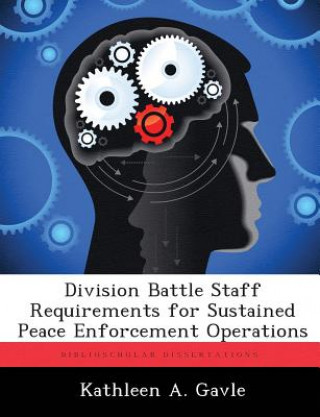
Kód: 08218349
Division Battle Staff Requirements for Sustained Peace Enforcement Operations
Autor Kathleen A Gavle
In December 1995, the Dayton Peace Accords led to a US Army deployment to Bosnia for participation in a complex, multinational peace enforcement mission, Operation JOINT ENDEAVOR. The 1st Armor Division led the first US force, Tas ... celý popis
- Jazyk:
 Angličtina
Angličtina - Vazba: Brožovaná
- Počet stran: 74
Nakladatelství: Biblioscholar, 2012
- Více informací o knize

Mohlo by se vám také líbit
-

Dismantling Democracy in Venezuela
4267 Kč -

Drugs and Behavior
4599 Kč -

Black Dwarf
1792 Kč -

Dam on the Homework River
749 Kč -

Arab Equitation
859 Kč -

Cancer Patience
432 Kč -

Literary Originality of the Gospel of Mark
1175 Kč
Darujte tuto knihu ještě dnes
- Objednejte knihu a zvolte Zaslat jako dárek.
- Obratem obdržíte darovací poukaz na knihu, který můžete ihned předat obdarovanému.
- Knihu zašleme na adresu obdarovaného, o nic se nestaráte.
Více informací o knize Division Battle Staff Requirements for Sustained Peace Enforcement Operations
Nákupem získáte 165 bodů
 Anotace knihy
Anotace knihy
In December 1995, the Dayton Peace Accords led to a US Army deployment to Bosnia for participation in a complex, multinational peace enforcement mission, Operation JOINT ENDEAVOR. The 1st Armor Division led the first US force, Task Force Eagle, to occupy Multinational Division North, and three other divisions have since served as the nucleus of Task Force Eagle. This monograph examines the division battle staff in light of the experiences in Bosnia to assess whether the traditional battle staff structures and operations meet the demands of a peace enforcement operation. The monograph sets the stage for this examination by establishing the combat battle staff as the baseline for comparison and then describing the operational environment for peace enforcement. With this background, the monograph analyzes three specific aspects of the division battle staff experiences in Bosnia: staff functions, structures, and procedures. Three criteria measure staff effectiveness in coordinating or facilitating the division's response to the demands of the peace enforcement operational environment. One is the ability to eliminate hostilities and enforce a peace agreement. Second is the ability to deal with civilians, including local government and law enforcement, non-governmental organizations (NGO), and the media. Last is the ability to assess progress towards accomplishing military tasks that support the political end-state. The result of this analysis is an identification of key players, structures, and procedures to conduct peace enforcement operations. The fundamental requirements for the planning staff in peace enforcement operations are the same as those for the battle staff in a combat operation, but there are some significant refinements. The planning process still requires a chief planner, and feedback is still critical to drive and adapt the process. The military decision making process remains the best way to rationalize the work of the planners. The differences in the
 Parametry knihy
Parametry knihy
Zařazení knihy Knihy v angličtině Society & social sciences Education
1646 Kč
- Plný název: Division Battle Staff Requirements for Sustained Peace Enforcement Operations
- Autor: Kathleen A Gavle
- Jazyk:
 Angličtina
Angličtina - Vazba: Brožovaná
- Počet stran: 74
- EAN: 9781286865767
- ISBN: 9781286865767
- ID: 08218349
- Nakladatelství: Biblioscholar
- Hmotnost: 150 g
- Rozměry: 246 × 189 × 4 mm
- Datum vydání: 01. October 2012
Oblíbené z jiného soudku
-

Oxford IB Diploma Programme: IB Economics Course Book
1594 Kč -

OET Preparation
246 Kč -

Cambridge IGCSE (R) & O Level Complete Physics: Student Book Fourth Edition
929 Kč -

Business Partner B2 Workbook
462 Kč -

Business Partner B1 Workbook
434 Kč -

Imagine If...
306 Kč -

OET Reading Subtest Preparation
343 Kč -

Vol 2 Blackletter Lettering Adventures
635 Kč -

AS & A Level Maths For Dummies
455 Kč -

CompTIA Security+ Review Guide - Exam SY0-601
621 Kč -

Amazing Autistic Brain Cards
1000 Kč -

Hanbo Jutsu: Use of Hanbo, Cane and Walking Stick for Self Defense
284 Kč -

Embodied Teen
545 Kč -

Blue Book of Grammar and Punctuation: An Easy- to-Use Guide with Clear Rules, Real-World Examples , and Reproducible Quizzes, Twelfth Edition
393 Kč -

Positive Discipline Tools for Teachers
433 Kč -

Oxford IB Diploma Programme: IB Theory of Knowledge Course Book
1466 Kč -

Oxford IB Study Guides: Economics for the IB Diploma
1120 Kč -

Speed and Accuracy: Division
208 Kč -

GCSE Spanish Exam Practice Workbook (includes Answers & Free Online Audio)
220 Kč -

KS3 Maths 10-Minute Weekly Workouts - Year 7
199 Kč -

Vertical Academy
919 Kč -

Grade 9-1 GCSE Maths AQA Revision Question Cards - Higher
242 Kč -

Human Landscapes from My Country
656 Kč -

Cambridge IGCSE (R) & O Level Complete Chemistry: Student Book Fourth Edition
992 Kč -

Oxford IB Diploma Programme: IB Course Preparation Mathematics Student Book
992 Kč -

1000 TRIOS or gapped sentences for Cambridge Advanced and Proficiency Exams
608 Kč -

Business Partner B1+ Workbook
462 Kč -

(ISC) SSCP SG & SSCP Practice Test Kit, 3e
1745 Kč -

Einkorn
519 Kč -

Czech Verbs
954 Kč -

Motivation and Reinforcement
1161 Kč -

Pearson Edexcel International GCSE (9-1) English Language B Student Book
1328 Kč -

Read Write Inc. Phonics: Red Ditty Book Bag Books (Mixed Pack of 10)
1587 Kč -

Oxford International Primary Maths Second Edition: Practice Book 1
323 Kč -

Forensic Linguistics Articles
417 Kč -

Corrected Squares of The Book of Abramelin
14513 Kč -

Exam Prep for Microeconomics by Pindyck & Rubinfeld, 6th Ed.
1089 Kč -

KS3 Maths 10-Minute Weekly Workouts - Year 8
199 Kč -

Reading Mind - A Cognitive Approach to Understanding How the Mind Reads
556 Kč -

Internet Protocol over Link-16
1646 Kč -

Effect of Registration Errors on Tracking in a Networked Radar System
1646 Kč -

Princeton Review SAT Premium Prep, 2021
1136 Kč -

CEH v11 Certified Ethical Hacker Study Guide + Practice Tests Set
1869 Kč -

10 Practice Tests for the SAT, 2021 Edition
841 Kč -

OCP Oracle Certified Professional Java SE 11 Programmer II Study Guide - Exam 1Z0-816 and Exam 1Z0-817
1336 Kč -

Prepared
876 Kč -

Powerful Teaching: Unleash the Science of Learning
665 Kč -

Physics for You
1249 Kč -

Sphagnum
363 Kč
Osobní odběr Praha, Brno a 12903 dalších
Copyright ©2008-24 nejlevnejsi-knihy.cz Všechna práva vyhrazenaSoukromíCookies



 Vrácení do měsíce
Vrácení do měsíce 571 999 099 (8-15.30h)
571 999 099 (8-15.30h)